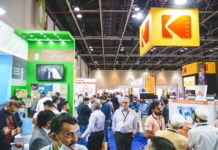Printers from around the country gathered at Pragati Flexo in Hyderabad on 6 February to have a look at the new UV flexo label press in action at an open house event organised and hosted by the Indian agents of MPS. Two print jobs were shown running to a group of printers from all over the country including label printers already having narrow web flexo presses and other large offset printers who are planning to get into the label business. Many of the industry suppliers of consumables and services were also present.
Narendra, Mahendra, and Chenga Reddy of Pragati Flexo welcomed the visitors and took great pains to show the press in complete details and to frankly share their understanding of the technology. To a large extent, the running press speaks for itself to audience that appreciates the structural strength of the press and the technical features that give it a competitive versatility.
Nevertheless Vijay Pareek, Director of Genius Flexo Marketing based in Mumbai and Erik Blomjous International Sales of Director of MPS explained some of the important features of the EF410 8-unit press preceding the demonstrations runs. Martin Stierle, International Sales and Marketing Manager of Kocher and Beck was also present at the demonstrations to explain the in-line diecutting and converting options on the press from his company. Pareek, Blomjous, and Stierle also made presentations at the post-lunch seminar held at a nearby hotel.
MPS was founded in 1996 and shipped its’ first designed from the ground up press, in 1999. Since then it has shipped 155 presses and 1000 units. Pragati is the first customer in India. Bomjous and Pareek emphasised the EF410 press’ superiority in avoiding three print problems of narrow web flexo presses: gear marking, barring (dot oscillation), and dot gain.
Gear marking and barring are a connected problem on many narrow web flexo presses. On the MPS presses there is solid lock technology for the entire carriage that contains the flexo plate cylinder, the anilox roller and its’ accompanying doctor blade. Bomjous explained, “Gears are made only for one position.”
Since the flexo plate cylinder on the MPS has its own servo motor and the entire carriage that contains it and the anilox and doctor is secured in place relative to the free running impression roller using the solid lock technology, gear marking and barring are eliminated.
The press also transfers what is called a “crisp dot” – a perfectly round dot with minimal dot gain because it uses three to five times less impression pressure. The impression roller is a free running roller with a special soft composition covering. The precise forward web movement uses servomotors at both infeed and rewind. Movement between units without stretch benefits from large diameter chilled rollers at the UV curing stations that gently “push” the web into the next print unit.
As Martin Stierle explained to the printers, Kocher and Beck have supplied the 12 and 16 inch plate cylinders and the die-cutting cylinders and tooling for the press. In addition the GapMaster technology that allows precise adjustment of the gap between the anvil body and cutting tool simply by turning the two-part latched dial, even when the press is running.











